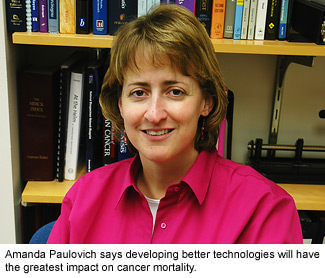Cancer care is at a crossroads. Science has identified key genes and proteins that go awry and result in this life-threatening illness, yet major advancements in the treatment of the disease remain rare. That's because many cancers are discovered only after they have spread throughout the body, making them difficult to cure.
Carnegie Mellon alumna Amanda Paulovich (S’88) wants to change this picture. She says the key to improving early detection and treatment is using cancer's molecular footprints.

“A cancer that is localized can be cured virtually 100 percent of the time with surgery and locoregional radiation," explains Paulovich, director of the Early Detection Initiative at the Fred Hutchinson Cancer Research Center in Seattle. “It’s so frustrating to be faced with the tiniest metastatic spot on an MRI scan and know that the cancer is incurable.”
Determined to improve the odds of survival for cancer patients, Paulovich, an oncologist and a geneticist, turned to her training in basic science.
“I wanted to use my science background to make an impact on cancer mortality, and the greatest chance of doing that in my lifetime is to focus on developing better technologies to detect cancer in its earliest and most curable stages,” she says.
Paulovich, who always wanted to be a physician, became passionate about basic research after attending the Pennsylvania Governor’s School for the Sciences (PGSS) at Carnegie Mellon. Her PGSS experience inspired her to attend Carnegie Mellon and pursue a degree in biology. During her first week on campus, she began working in the lab of John Woolford, professor of biological sciences . Her research there ultimately led to the publication of three papers, including one in which she was the first author.
Looking back, Paulovich realizes that doing such high caliber research as an undergraduate – and being treated as an equal in the lab – was a remarkable and empowering opportunity. “The experience I had as an undergrad at Carnegie Mellon has impacted how I manage my own team,” she says.
She also had the privilege of interacting with Elizabeth Jones, the Dr. Frederick A. Schwertz Distinguished Professor of Life Sciences, and Susan Henry, former dean of the Mellon College of Science (MCS). “There are few women who fill big roles in science, so it’s important for young women to have exposure to female role models who have succeeded,” says Paulovich.
After graduating from Carnegie Mellon in 1988, Paulovich went on to earn a doctor of medicine and a doctorate in genetics from the University of Washington under the guidance of Lee Hartwell, a Nobel laureate recognized for his discoveries of key molecules that regulate cell division and death.
While completing her residency and an adult oncology fellowship at Dana-Farber Cancer Institute in Boston, she also conducted post-doctoral work with Eric Lander at the Whitehead Center for Genomic Research. There, she focused her research efforts on understanding how cells are affected by damage to their DNA. Cells normally repair errors in their DNA to maintain critical processes such as cell growth and division.
“There is a hypothesis that inherited differences lead to most of the more common forms of breast cancer, although these genetic differences are less severe than those caused by the BRCA genes [which are linked to the development of breast cancer at an early age],” Paulovich says.
According to Paulovich, evidence suggests that heritable defects in cells’ ability to repair DNA may play such a role. To test this hypothesis, Paulovich is developing technologies that will analyze proteins involved in a DNA repair pathway and that will monitor DNA damage. Ultimately, she wants to develop a blood test that will identify defects in cells’ DNA repair mechanisms. This could provide early indication of whether a woman is likely to develop breast cancer later in life.
In addition to identifying proteins involved in DNA repair, Paulovich is looking for other key proteins associated with breast cancer. Cancer cells produce unique sets of proteins and release them into the blood, where they could be detected, she explains. Paulovich plans to compare all of the proteins in blood samples taken from mice with and without cancer to pinpoint any differences, a method called comparative proteomics. Identifying such proteins could form the basis of future studies in people.
“This year, we are setting up a platform for our research. Comparative proteomics is in its infancy, and many labs go about the task in their own way. We’d like to develop a set of standard protocols and procedures for testing and processing data,” says Paulovich.
Once the technology has been developed, Paulovich and her team will look for the proverbial needle in the haystack – the proteins produced only by cancer cells. Using a blood test, doctors could detect these proteins in a patient’s blood to diagnose a cancer in its earliest, and most treatable, stages and to monitor its response to treatment.
Although it is a daunting task, Paulovich believes that her work at Fred Hutchinson is an opportunity of a lifetime. Woolford knows she’s ready for the challenge. “Mandy is one of those rare people who contributes in outstanding ways to both science and medicine. She has the practical mind to identify information in basic science and translate it to the clinic,” Woolford says.
Related Links:
Fred Hutchinson Cancer Research Center
Pennsylvania Governor’s School for the Sciences
John Woolford
Biological Sciences
Elizabeth Jones
Mellon College of Science
Lee Hartwell
Dana-Farber Cancer Institute
Whitehead Center for Genomic Research



